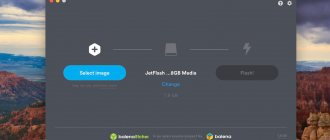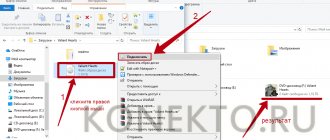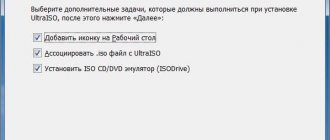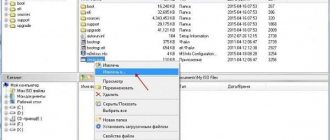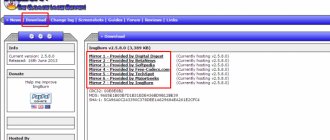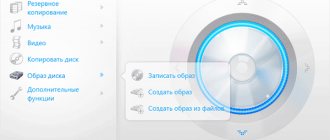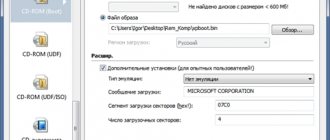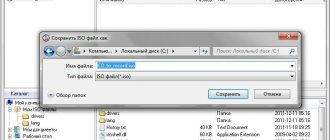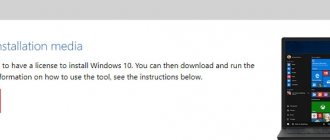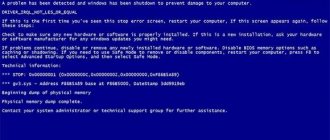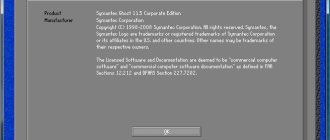Situations when an image is needed
Using an OS image, you can reinstall everything from scratch. It is also possible to correct errors when starting the operating system or clean your PC of unnecessary and unnecessary programs. Main reasons to use:
- OS reinstallation;
- restoring the OS in case of problems.
You can create an image if you use programs such as:
- archiving wizard;
- installer;
- third-party: Nero Express, UltraISO, etc.
How to restore Windows 10 from a backup
To restore Windows 10 from a backup, you need to go to the system recovery menu. It can be opened in different ways. We will consider two cases: when the system boots (the computer turns on), and when there are problems loading Windows (errors, blue screens, hard drive failure, etc.).
During the recovery process, all files on the local disk will be replaced with files from the image. This means that, for example, if you created a file after creating a backup copy, it will be deleted. Of course, only on the partition that will be restored.
Let's look at both options:
- In the first case, when Windows 10 boots, you need to go to “Start” - “Settings”, and go to the “Update and Security” section. Then open the “Recovery” tab and click on the “Restart now” button.
Or on the lock screen, press the power button, hold down the Shift key and select “Restart”. - If the system does not boot, then we will need a bootable installation disk (flash drive) with Windows 10, or a recovery disk (flash drive), which the system suggested creating during the backup process. You can create a recovery disk on another computer using these instructions. You can also burn a boot disk with Windows 10, or a bootable USB flash drive. Then we need to boot from this disk/flash drive. This can be done in two ways: set to boot from the required drive in the BIOS settings, or through the Boot Menu, which is usually called up with the keys: F12, Esc, F8, F9 when turning on the laptop or PC.
If you are booting from an installation disk, then after selecting the language you need to click on “System Restore”.
Next, click on “Troubleshooting”.
Select "More options".
We are interested in the “System image restoration” section.
The drive on which the Windows 10 backup is stored must be connected to the computer. The system itself will find and offer you the latest available system image. If necessary, you can select the image manually.
In the next window, there is an option to format the entire hard drive and re-partition it. But this will delete all data from the hard drive. Most likely you just need to click “Next”. Only those partitions that are in the backup copy will be overwritten. Other sections will not be affected.
Then simply click “Finish” and confirm replacing the data from the system image.
All that remains is to wait until the process of restoring the computer from the image is completed. The speed depends on the size of the image itself, the drive on which it is stored, and the drive installed in the computer.
Other backup options
Everything I wrote about above can be done through DISM. Running commands on the command line. In the same way, you can restore an image created in DISM. True, I don’t see the need for this when it is possible to create an image through a separate tool in the system, and restore it by pressing a few buttons, and not by running 10 commands.
There are also special programs that can be used to create a complete image of the system partition with Windows 10, or other partitions, and restore them if necessary. Popular free programs: Macrium Reflect Free, Aomei Backupper Standard. True, they are in English. Therefore, I advise you to use the standard method, which I wrote about in detail above.
We are working on creating a Windows 10 image
Necessary tools to create a Windows 10 image
We prepare the necessary tools for this process. You may need things like:
- SSD disk (external);
- USB drives;
- DVDs.
Next, select the appropriate option (all options are described below) and begin work.
Windows image storage location
You can see the location of your archive files, as well as find out the space it occupies.
A visual view of storing an image of your system:
Type of storage of your system image
An example of the location of the image can be seen in the screenshot.
Example of image location
To find out the size of the archive, right-click on the folder and go to “Properties”.
Go to “Properties”
Possible problems
If you follow everything according to the instructions, there should be no problems. However, let's look at the possible options:
- the download does not start : if the process hangs from the very beginning, then you need to check the Internet connection and the antivirus blocking; perhaps it is blocking the service. Also check the storage capacity (there may not be enough space);
- the process freezes at a certain point : in this case, there is a high probability that you have a problem with the hard drive. In this situation, you can make several attempts to correct this situation.
- Check your system for virus programs.
Virus in the system
- Press the combination “Win + X” -> “Command Prompt”. Enter the command: “chkdsk C: //”. We accept the verification and reboot the computer.
- the disk or flash drive does not work: replace the image and rewrite the installation disk;
- Lost connection with the drive: let's try to clean the disk and start the installation again. There are situations when the only solution is to replace the disk.
In fact, burning a system image to disk is not such a difficult task, so problems are encountered very rarely.
Creating a Windows 10 ISO System Image Using DataNumen
One popular way to use disk images is to create a clone of the hard drive (HDD or SSD) that may end up in the last place.
DataNumen Disk Image (also known as "DDKI") is one such solution, works on all versions of Windows and is available as free software.
After downloading and installing the utility, use the Clone tab to select the drive from which you want to create an image; To clone multiple disks, use the “Batch Clone” tab.
Select the destination and assign the file name in the "Output image file as" field as the field in which to select the destination drive. This is the device you use to save your backup. This could be an existing external drive or a hard drive you recently purchased.
Click Start Cloning. This copies your disk to the target device, ready for use.
Installing Windows 10 from an image
You can install the OS without certain skills and abilities.
- Insert the flash drive or disk into the PC and restart the computer. Press any button and the BIOS window appears.
- Select the basic settings and click “Next” -> “Install”.
- Enter the product key, if available. Or click the “No key” button.
Enter the key or click “Skip”
- Next, we accept the agreement and select the installation type (custom installation should only be selected by experienced users).
- Select the partition in which the system will be installed. We are waiting for the process to complete.
Select the partition in which the system will be installed and click “Next”
After installation, we configure the system (creating an account, setting standard parameters).
Creating an ISO Disk Image in Windows 7
Even though cloud backup is easy, there is no reason not to prepare an ISO disk image for disaster recovery scenarios. You can make an image of the system in its current state. Alternatively, you can create an image of a recently installed operating system. This may include some apps and games you have installed.
If you are using Windows 7, backing up the ISO disk image is part of the Windows 7 Backup and Restore feature. The Windows 7 Backup and Restore feature.
To create a system image in Windows 7, open Start → Get Started → Back up Files. In the left pane, click Create System Image and select a destination.
This could be an external hard drive or another large volume. You can also burn to DVD (you'll need more than one) or Blu-ray.
Do you have a home server or some large network storage, perhaps in the form of a purchased NAS? If so, you can use the Online option. If you want to use a USB flash memory device, please connect it to your computer in advance and select it as the destination.
Also make sure that the system drive is selected (C: drive by default).
A confirmation screen will indicate how much space will be taken up by the backup. Check this to ensure that the design matches the remaining space on the target device. Continue with the backup and wait for it to complete. The duration will depend on the backup size and disk speed.
